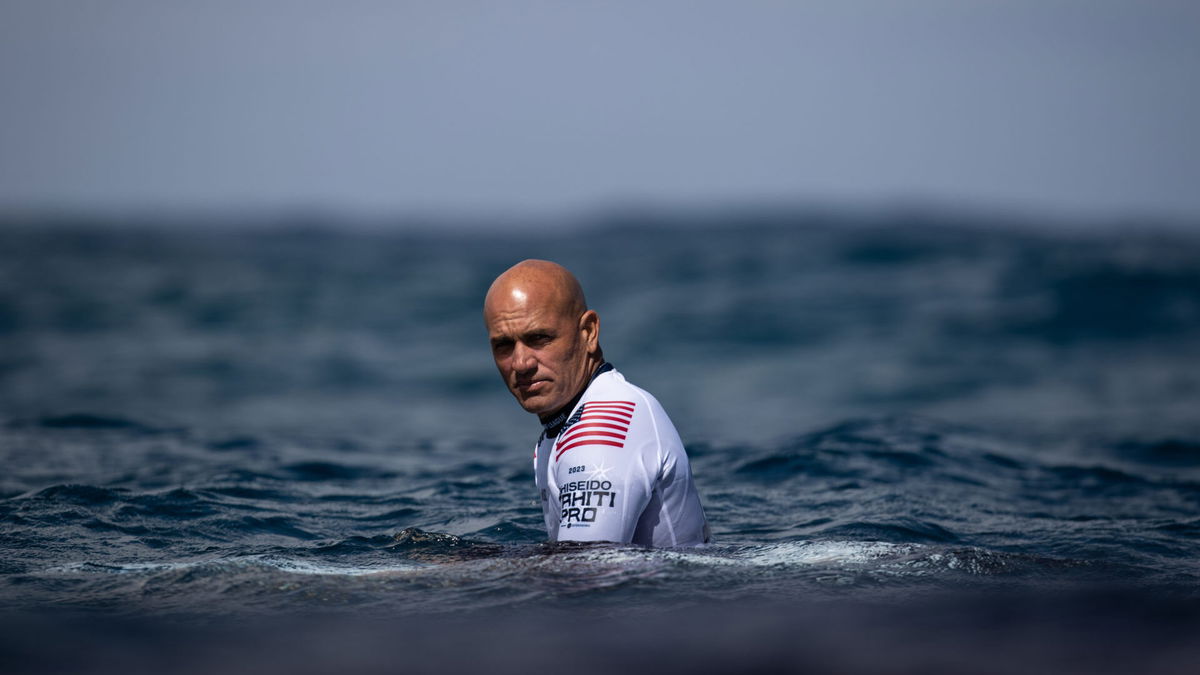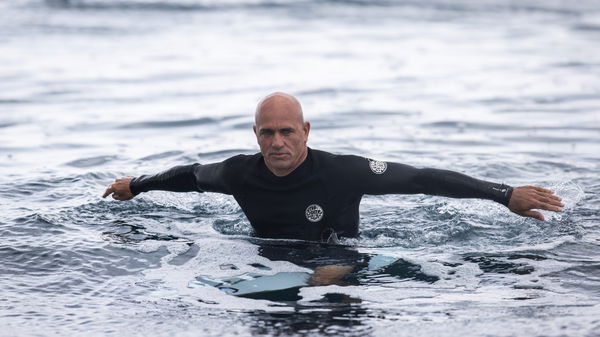
Getty
TEAHUPO’O, FRENCH POLYNESIA – AUGUST 11: Kelly Slater of United States reacts during his Opening Round Heat during day one of the SHISEIDO Tahiti Pro on August 11, 2023 in Teahupo’o, French Polynesia. (Photo by Ryan Pierse/Getty Images)

Getty
TEAHUPO’O, FRENCH POLYNESIA – AUGUST 11: Kelly Slater of United States reacts during his Opening Round Heat during day one of the SHISEIDO Tahiti Pro on August 11, 2023 in Teahupo’o, French Polynesia. (Photo by Ryan Pierse/Getty Images)
Bali’s always been a serene tourist hotspot, but for surfing legends like Kelly Slater, it’s a home and a haven. And when it comes to Uluwatu? That’s where the real magic happens! This iconic surf spot has been drawing in wave chasers since the ’70s with its epic breaks and breathtaking views. Uluwatu’s got five legendary peaks—Temples, The Bombie, Outside Corner, The Peak, and Racetrack—each serving up something special depending on the tide and swell. But now, instead of just surfing, Uluwatu is making waves for all the wrong reasons.
Watch What’s Trending Now!
Developers are tearing into those famous limestone cliffs to build a seawall and a coastal road, threatening to bury the reef beneath concrete. Surfers are speaking out, and none louder than Kelly Slater, who’s ringing the alarm for this surfing paradise.
On September 30, Kelly Slater hopped onto his Instagram stories, sharing a reel from pro surfer Nic von Rupp about the massive trouble brewing at Uluwatu, Bali. His message? Short, sharp, and straight to the point: “What’s happening in Bali at Uluwatu is crazy.” And he didn’t stop there.
ADVERTISEMENT
Clearly disturbed, he added, “I don’t know the end goal but it sure isn’t headed in the right direction.” Nic von Rupp, Portugal’s surfing powerhouse, had dropped the reel, showing exactly what was going down at this iconic surf spot. Developers have rolled in with excavators, smashing down those limestone cliffs to build the wall and the road.
Not only is this a nightmare for surfers and the perfect waves, but it’s also putting marine life—like turtles and dolphins—in danger. The kicker? This whole seawall project is supposedly meant to protect the Pura Luhur Uluwatu Temple, which has stood proudly on the cliff’s edge for centuries. Cracks started showing after a 1992 earthquake, but the government’s response back then was to limit visitor numbers.
Fast forward to 2024, and they’ve allocated a whopping 78.6 billion rupiahs (about $5 million) to fix those cracks and stop wave damage from making things worse. But now, with construction in full swing, people are starting to question if this massive wall will do more harm than good. And it’s not just the wall itself.
ADVERTISEMENT

Getty
TEAHUPO’O, FRENCH POLYNESIA – AUGUST 15: Kelly Slater of United States warms up before their Round of 16 heat on August 15, 2023 in Teahupo’o, French Polynesia. (Photo by Ryan Pierse/Getty Images)
To even start this massive build, the developers have bulldozed one of the last untouched areas of land around Uluwatu. Surfers argue the new coastal road will encroach on several of Uluwatu’s less-frequented surf spots — Secrets, Lurches, and temples. This will manipulate the reef to achieve structural stability, a move that would impact the surrounding waves, according to the popular surf magazine Stab. To make matters worse, the section of the reef closest to the temple is said to be a critical breeding nursery for manatees and spinner sharks.
ADVERTISEMENT
Video footage of construction works that are doing rounds in social media shows heavy machinery leveling the cliff face for the coastal road as large pieces of rock fall into the surf below. Balinese local Piter Panjaitan, who has been sharing footage of the works on his page is outraged. “No Trucks to carry the limestone out? Just throw it to the ocean? Irresponsible Contractor? No supervision?” he posted.
The pristine place first came to notice of the outside world way back in the 1970s. Bali was a different place back then. The tourism industry had not yet taken hold, and Uluwatu was just a secluded place. What brought this place to the notice of the world was the 1972 film Morning of the Earth, directed by Alby Falzon and David Elfickm, arguably one of the greatest surfing movies. The film first screened on February 25, 1972, at the Manly Silver Screen Theatre in Sydney, Australia, and became an instant hit with sold-out shows for several months.
Two surfers in the film, Stephen Cooney and Rusty Miller, became the first to ever surf in Uluwatu. After that landmark film, the floodgates opened with an influx of 20,000 tourists in 1973, 1000 among them being surfers. Then in 1975, Gerry Lopez, a well-known surfer at that time along with legendary Hawaiian surfer, and 2X Pipeline surfing champion Rory Russell, found the waves of Uluwatu.
ADVERTISEMENT
“We discovered the biggest candy store for surf there could ever be. We were completely and utterly just blown away by not only the quality but the consistency of the surf and the lack of people,” Gerry Lopez had said about their first look at Uluwatu. The two went on to shoot the film Chasing The Lotus. In the following years, people like Jim Banks, who crafts some of the world’s best surfboards fell in love with the place.
“In 1977 I had finished school and started shaping at Gordon and Smith in Cronulla. By June, at the age of 17, I packed a couple of single fins and took off for Bali. It was life-changing for me,” the bio section of Jim’s website reads. He now lives in Bali full-time and chases the Uluwatu waves daily. Environmentalists and surfers fear that with the new construction the magic that has attracted such established names to the destination will be in danger.
Nic von Rupp and Kelly Slater are still in disbelief that this is happening in a world that’s all about protecting the ocean. Nic’s rallying everyone to “sign the petition” in his bio to stop the destruction of this legendary surf spot. And of course, Kelly Slater’s fully on board. Why wouldn’t he be? The oldest surfer still active in the World Surf League is all about keeping the planet (and the waves) safe!
ADVERTISEMENT
Kelly Slater: Surfing icon and environmental crusader
Kelly Slater, with 56 Championship Tour wins, is all about living green and is riding the wave of sustainability too. His clothing brand, Outerknown, is all about eco-friendly fashion, and his Firewire surfboards? Made with the most sustainable materials out there. Slater’s passion for ocean conservation hit home when he was surfing in France and saw plastic bags floating in the water.
He said, “If I fall and get a mouthful of water, I might choke on a plastic bag,” he thought. “Once you have an awareness around something, (you) change immediately.” He’s also teamed up with the Sea Shepherd Society and Reef Check to help protect coral reefs, and he even started The Kelly Slater Foundation to support charities focused on the environment and social issues.
ADVERTISEMENT
On theSea Has Many Voices podcast with Dr. Stone, Slater summed up his mission perfectly: “I feel like I have an obligation to pass on positivity, whether that’s about the environment, how you act towards people, the choices you make… how you spend your money.”
Top Stories
Cowboys Fire Defensive Coordinator Matt Eberflus: Contract, Salary, NFL Earnings & More

Adam Peaty Faces Gordon Ramsay’s Sly Dig Amid Parents’ Controversial Wedding Absence

Russell Wilson Announces Retirement Stance as Giants QB Shares Hidden Injury News

Marina Mabrey Is Raising Eyebrows Again With Fiery Unrivaled Confrontation

Huge Fire Destroys Over 125-Year-Old Golf Club Designed by 5x Open Winner in London – Report

Dolphins Reportedly Indecisive About Mike McDaniel as GM Search Kicks Off

In fact, Kelly was one of the most prominent voice during the Paris Olympics when a controversy began with its surfing destination Teahupo’o. Known to harbor one of the most dangerous waves in the world, Teahupo’o was in the center of discussion when the Paris 2024 authorities decided to erect a $5m aluminum judges’ tower in the reef, replacing the existing wooden one.
Environmentalists feared that drilling new foundations into the reef would harm the ecosystem and increase levels of ciguatera, a microscopic algae that infects fish, thereby poisoning the local food chain. Kelly strongly stood beside the voices.
ADVERTISEMENT
“Doesn’t make sense to need such a giant tower for a 2 days event one time. Give the money to local infrastructure in the town for all the damage done from changing the river that caused floods earlier this year. The judges can get on that tower. Or rebuild the frame on same footing,” he had written. With his latest call to action to save Bali’s iconic Uluwatu, Slater proves once again he’s a relentless force in his sport for the planet and the people.
ADVERTISEMENT
ADVERTISEMENT
ADVERTISEMENT

